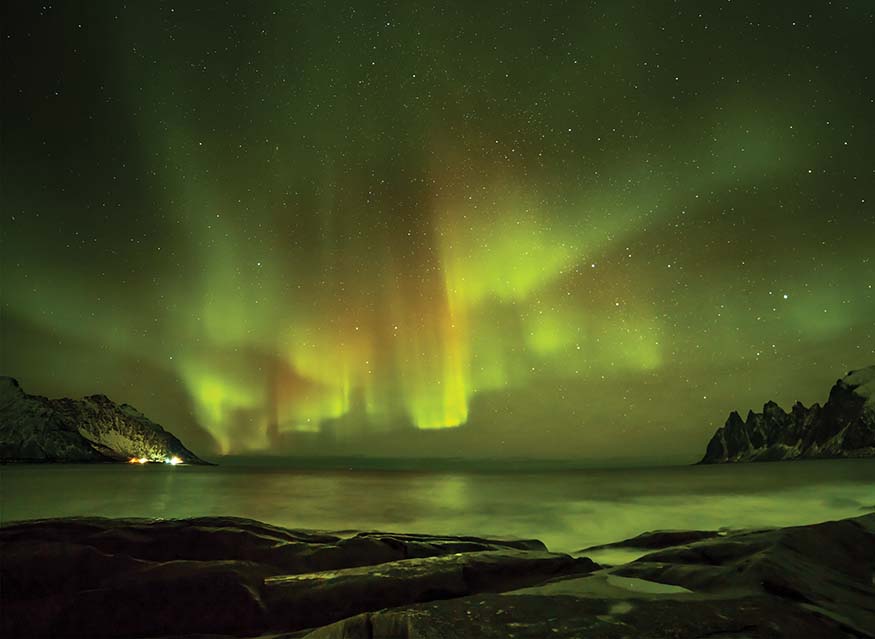
BEAUTY: 
BRAGGING RIGHTS: Must see
HOW EASY IS IT TO SEE? Dark skies required
TYPE: Special event
DISCOVERED: Known since antiquity
The most important celestial object for us is, of course, the sun. Without it Earth would be a lifeless, frozen hunk of rock; but we take it for granted because it seems constant and unchanging—few things are more certain than “the sun will rise tomorrow.”
Aurorae, also known as the Northern Lights, are a visible reminder that the sun does change, and that its behavior can be both predictably cyclical and outright capricious.
In September 1859 a solar storm shot a massive burst of gas and electromagnetic radiation out into space, and Earth just happened to be in its path. The burst induced a massive current on all electrical devices. Fortunately, this was before homes had electric lights, so the only damage was to telegraph equipment, which often burst into flames.
That night, the Northern Lights were visible as far south as Mexico, and people in the US could easily read newspapers by aurora light.
The aurorae occur because of a complex interaction between the solar wind and the Earth’s magnetic field. High-energy particles strike the oxygen and nitrogen in our atmosphere, causing them to glow like massive neon signs. And the aurorae become brighter when there’s more energy from the sun.
Of course, normal aurorae pose no threat to our cell phones and electronic gadgets—the solar wind is usually far too weak to cause anything more than a spectacular light show. But someday, something like the 1859 solar storm will hit our planet again.
WHAT YOU MIGHT SEE THROUGH AMATEUR EQUIPMENT
In 2012, a spacecraft in deep space detected a massive burst of energy from the sun. Fortunately, the blast missed the Earth. But based on measurements from the spacecraft, the blast was at least as powerful as the 1859 event. Had it hit us, it would have disabled every unprotected electronic device on the planet. Someday, maybe a century from now, maybe tomorrow, we won’t be so lucky. Until then, we can look up and admire the Northern Lights, never forgetting that their gentle beauty is due to the ferocious and unpredictable sun.
The Northern Lights are generally visible in far northern latitudes, from Alaska down to the northern United States. The best time to see them is during the long nights of winter, when there is plenty of darkness. The greater the solar activity, the further south you’ll be able to see them.
The sun goes through an 11-year cycle of increased activity followed by a less-active period. Aurorae are most likely to be visible during active parts of the cycle. As of this writing, the most recent cycle (Cycle 24) peaked in early 2014. The next peak is not expected until the mid-2020s.
Unfortunately, there is no guaranteed way to see the Northern Lights, and most predictions of when and where they might be visible are only good a couple of days in advance. Your best bet is to spend an extended period of time at latitudes where aurorae are seen and wait patiently—their beauty will be worth it.
Curtains of light. The aurora appear as multicolored curtains of light waving and dancing in the darkness. They appear somewhat flat or two-dimensional because of the shape of the magnetic field, which channels the high-energy particles along circumpolar arcs.
The gentle waving and pulsing of the aurorae is mesmerizing—clear your mind as you’re watching and take in their beauty.
Under the aurorae. Unlike the moon and stars, the aurorae actually occur within our atmosphere. That means you can change your view by getting closer to them. From far away, the aurorae will look like sheets of light near the horizon. But you can travel toward them (perhaps on subsequent nights) to see them better. If you’re lucky and travel far enough, you can see them directly above you.
Atomic colors. The colors of the aurorae are caused by excited atoms releasing photons at specific frequencies; this is similar to how particular gases in neon signs produce specific colors of light.
Green is the most common color in aurorae, and it’s caused by dense molecular oxygen. Higher in the atmosphere you may see faint reds emitted by more rarefied oxygen. And of course, you may see the aurorae in vivid combinations, sometimes even including yellows and pinks. Molecular nitrogen sometimes plays a part, too, emitting at various wavelengths, but it mostly produces blues and purples.